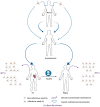Impact of sequelae of visceral leishmaniasis and their contribution to ongoing transmission of Leishmania donovani
- PMID: 31589291
- PMCID: PMC6830496
- DOI: 10.1093/femspd/ftz057
Impact of sequelae of visceral leishmaniasis and their contribution to ongoing transmission of Leishmania donovani
Abstract
Visceral leishmaniasis (VL) in the Old World is caused by infection with Leishmania donovani. Although the numbers of new reported cases of VL in Africa have been relatively stable for several years, the low numbers currently reported on the Indian subcontinent suggest a positive impact of new treatments and intervention strategies. In both regions, however, VL relapse and post-kala-azar dermal leishmaniasis (PKDL) maintain infectious reservoirs and therefore present a threat to control programs. In this review, we outline the evolving appreciation of PKDL as an impactful disease in its own right and discuss the various diagnostic methods that can be applied for the detection and characterization of PKDL cases. We also highlight the data that indicate the potential, and likely contribution, of PKDL cases to ongoing transmission of L. donovani.
Keywords: Leishmania; biomarkers; diagnosis; protozoa.
© FEMS 2019.
Figures



References
-
- Antinori S, Calattini S, Longhi Eet al. .. Clinical use of polymerase chain reaction performed on peripheral blood and bone marrow samples for the diagnosis and monitoring of visceral leishmaniasis in HIV-infected and HIV-uninfected patients: a single-center, 8-year experience in Italy and review of the literature. Clin Infect Dis. 2007;44:1602–10. - PubMed
Publication types
MeSH terms
Grants and funding
LinkOut - more resources
Full Text Sources

